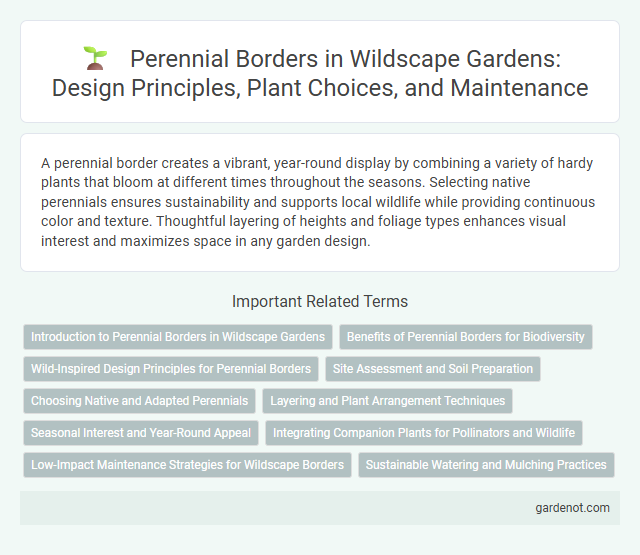A perennial border creates a vibrant, year-round display by combining a variety of hardy plants that bloom at different times throughout the seasons. Selecting native perennials ensures sustainability and supports local wildlife while providing continuous color and texture. Thoughtful layering of heights and foliage types enhances visual interest and maximizes space in any garden design.
Introduction to Perennial Borders in Wildscape Gardens
Perennial borders in Wildscape gardens feature diverse, long-lasting plants that thrive in local climates, providing year-round visual interest and supporting native wildlife. These carefully curated arrangements enhance biodiversity by attracting pollinators such as bees, butterflies, and birds, which are essential for ecosystem health. Incorporating drought-tolerant and native species ensures sustainable garden maintenance and resilience against environmental stress.
Benefits of Perennial Borders for Biodiversity
Perennial borders support biodiversity by providing a continuous habitat and food source for pollinators, birds, and beneficial insects throughout the seasons. Their deep root systems improve soil health and promote microbial diversity, enhancing ecosystem resilience. Strategically planted perennial borders within a wildscape create vital corridors that connect fragmented habitats, encouraging species movement and genetic diversity.
Wild-Inspired Design Principles for Perennial Borders
Perennial borders inspired by wildscape design emphasize native plant species that support local biodiversity and create resilient ecosystems. Utilizing layered planting with varied textures, heights, and bloom times encourages year-round habitat for pollinators and wildlife. Strategic placement of drought-tolerant and soil-adaptive perennials reduces maintenance while enhancing natural beauty and ecological function.
Site Assessment and Soil Preparation
A successful perennial border begins with a thorough site assessment analyzing soil type, drainage, sunlight exposure, and existing vegetation to ensure optimal plant selection and growth. Soil preparation involves amending the ground with organic matter, such as compost or well-rotted manure, to improve fertility, structure, and moisture retention. Testing soil pH guides amendments, ensuring nutrient availability tailored to specific perennial species, resulting in a robust, thriving border.
Choosing Native and Adapted Perennials
Choosing native and adapted perennials for a Wildscape perennial border enhances ecosystem resilience by supporting local pollinators and wildlife. Native perennials such as Echinacea purpurea and Monarda fistulosa thrive with minimal maintenance while promoting biodiversity. Incorporating adapted varieties ensures year-round visual interest and sustainable growth in varying soil and climate conditions.
Layering and Plant Arrangement Techniques
Layering in a perennial border involves arranging plants by height, texture, and bloom time to create depth and visual interest, enhancing ecological benefits. Strategically placing taller perennials like Echinacea at the back with mid-height plants such as Salvia and ground covers like Heuchera in front optimizes sunlight access and supports pollinators. Combining diverse foliage colors and flowering periods ensures continuous seasonal appeal and habitat variety in the wildscape garden.
Seasonal Interest and Year-Round Appeal
Perennial borders in Wildscape gardens provide vibrant seasonal interest with a diverse mix of flowering plants that bloom from spring through autumn. These borders are designed to maintain year-round appeal by incorporating evergreen foliage, textured leaves, and winter-hardy species that offer color and structure even in colder months. Careful plant selection ensures continuous visual excitement, supporting wildlife habitats throughout all seasons.
Integrating Companion Plants for Pollinators and Wildlife
Integrating companion plants in a perennial border enhances biodiversity by attracting pollinators like bees, butterflies, and hummingbirds, which are essential for ecosystem health. Native flowering perennials such as Echinacea, Rudbeckia, and Salvia provide nectar and habitat, supporting a wide range of wildlife throughout the seasons. Strategically combining these plants creates continuous bloom cycles, improving pollination work and sustaining local wildlife populations effectively.
Low-Impact Maintenance Strategies for Wildscape Borders
Wildscape perennial borders thrive with low-impact maintenance strategies that prioritize native plant species and natural growth cycles, reducing the need for chemical fertilizers and pesticides. Implementing mulch layers conserves moisture, suppresses weeds, and enriches soil health, enhancing plant resilience and biodiversity. Strategic pruning and selective weeding paired with seasonal monitoring optimize long-term sustainability and ecosystem balance within wildscape environments.
Sustainable Watering and Mulching Practices
Perennial borders benefit from sustainable watering practices such as drip irrigation and rainwater harvesting, which conserve water and promote healthy root growth. Mulching with organic materials like bark or compost helps retain soil moisture, suppress weeds, and improve soil structure. These methods reduce water usage, enhance plant resilience, and support long-term ecosystem health in wildscapes.
Perennial border Infographic

 gardenot.com
gardenot.com